Cape Town Sustainable Fashion Designers Leading the Eco-friendly Movement
Cape Town Sustainable Fashion Designers Leading the Eco-friendly Movement
Blog Article
Keep Ahead of the Contour by Discovering Innovative Fashion Fads
In a market as vibrant as style, staying ahead includes greater than just complying with current patterns-- it requires an exploration of development. Smart fabrics, as an example, are changing garments into useful work of arts, while 3D printing is changing design processes with its customizable, waste-reducing capacities. As sustainability becomes a keystone, innovations like eco-friendly products and circular fashion techniques are reshaping environmental obligation - Cape Town Sustainable Fashion. Moreover, the merging of modern technology and style proclaims a new era of consumer involvement. How, after that, can these emerging fads redefine the future of style, and what effects do they hold for brands looking for to thrive in this progressing landscape?

Accepting Smart Textiles
Recently, the fashion business has actually experienced a transformative shift with the assimilation of clever textiles, an advanced innovation that blends technology with material. This evolution represents not just a combination of aesthetics and performance yet additionally a substantial jump towards sustainability and personalization in vogue. Smart textiles, additionally recognized as e-textiles, installed advanced electronics such as sensing units and conductive threads within the textile, making it possible for garments to communicate with the user or the environment.
These textiles are made to keep an eye on physiological criteria, such as heart rate or body temperature level, providing real-time health and wellness analytics. Past health applications, clever textiles are likewise being made use of for flexible clothes, which can transform color or pattern in response to environmental stimuli, hence offering a vibrant fashion experience.
Furthermore, the advancement of energy-harvesting textiles that generate power from activity or sunshine is leading the means for self-sufficient wearable innovation. This innovation is attracting ecologically mindful consumers and designers aiming to decrease the ecological impact of style. As research and advancement in this area advance, wise textiles are expected to become progressively widespread, improving the landscape of contemporary fashion with their multifunctional capabilities.
The Surge of 3D Printing
Transforming the production landscape, 3D printing has become a game-changer in the style sector. This advanced technology has actually enabled designers to press the borders of creativity, generating intricate and customized garments that were formerly inconceivable. By leveraging digital design and additive manufacturing, 3D printing facilitates the development of intricate geometries and patterns, permitting developers to explore new textures and structures.
A notable benefit of 3D printing in vogue is its capability to create on-demand, reducing waste and reducing stock requirements. This efficiency not only enhances manufacturing procedures yet likewise enables for quick prototyping, making it possible for developers to bring their visions to life in a much shorter timeframe. Moreover, 3D printing sustains customization to a degree unparalleled by traditional techniques, supplying tailored fits and one-of-a-kind designs tailored to specific consumer preferences.
The surge of 3D printing has actually additionally democratized style, making it obtainable to arising designers who can currently fabricate top notch pieces without considerable economic investment in standard production facilities. As technology proceeds to breakthrough, the garment industry is positioned to harness the complete potential of 3D printing, checking out brand-new products and strategies that will undoubtedly redefine exactly how style is developed and produced.
Sustainable Style Developments
As the garment industry grapples with journalism requirement for environmental responsibility, lasting style developments have emerged at the center of transformative adjustment. The growing recognition of environmental influence has sustained a shift in the direction of more eco-conscious practices and products. Brand names and designers are now prioritizing sustainability, including techniques that decrease waste and minimize carbon footprints.
One substantial growth is the rise of circular fashion, which emphasizes recycling and upcycling to expand the lifecycle of garments. This technique not just minimizes waste however additionally motivates customers to adopt a much more mindful approach to clothing consumption. In addition, using lasting materials, such as natural cotton, hemp, and recycled polyester, has actually gained grip. These materials need less water and power throughout production, significantly decreasing ecological influence.
One more development hinges on the fostering Read Full Article of innovative dyeing strategies that make use of natural dyes or waterless processes, thereby lowering the vast quantities of water and chemicals commonly utilized in fabric dyeing. In addition, developments in biotechnology have actually brought about the development of lab-grown leather and materials, offering cruelty-free and ecologically pleasant choices to standard products. Through these introducing efforts, the garment industry is making meaningful strides in the direction of a much more sustainable future.

Tech-Integrated Garments
Tech-integrated apparel stands for a cutting-edge blend of fashion and technology, reshaping just how people engage with their garments. This cutting-edge domain is noted by the inclusion of wise textiles and embedded digital parts, enhancing both performance and visual appeal. From physical fitness trackers embedded in sports apparel to heated jackets controlled by means of mobile phone apps, tech-integrated clothing offers consumers unmatched comfort and flexibility.
Introducing brand names are driving this fad, concentrating on developing garments that react to environmental stimuli or user commands. As an example, some garments can alter shade or pattern in action to temperature changes, while others integrate biometric sensing units to monitor wellness metrics like heart rate or stress and anxiety levels. The smooth combination of innovation into fabrics also prolongs to environmental sustainability, with efforts to create self-cleaning textiles or garments that readjust to climate condition, thus lessening the need for multiple layers.
Furthermore, the development of wearable innovation is not simply limited to apparel yet prolongs to devices like watches and eyeglasses, more broadening the scope of tech-integrated style. As the industry continues to introduce, the possibility for customization and personalization in garments grows, supplying customers distinct, tech-enhanced style experiences that provide to their individual demands and preferences.
Future of Virtual Style
Recently, the future of virtual fashion has emerged as a transformative pressure within the market, leveraging developments in electronic technology to redefine how style is produced, experienced, and eaten. By integrating increased reality (AR), online fact (VIRTUAL REALITY), and 3D design tools, developers can currently craft immersive and interactive experiences that go beyond standard style borders. Virtual fashion enables for the production of garments that exist only in electronic atmospheres, using countless opportunities for advancement without the restrictions of physical manufacturing.
This electronic change not just offers chances for innovative expression yet likewise addresses sustainability worries integral in conventional style practices. Cape Town Sustainable Fashion. By getting rid of the requirement for physical resources, virtual style reduces waste and decreases carbon footprints. Furthermore, the rise of digital fashion aligns with the increasing customer need for special and personalized experiences, as online garments can be personalized and customized to specific choices effortlessly

Conclusion
The fashion industry's future lies in the integration of ingenious technologies and lasting practices. Digital fashion is positioned to redefine customer communications.
In recent years, the fashion industry has seen a transformative shift with the combination of clever textiles, a cutting-edge advancement that mixes technology with explanation fabric.As the fashion sector grapples with the pressing requirement for ecological obligation, sustainable style advancements have arised at the leading edge of transformative modification.In recent years, the future of online fashion has actually arised as a transformative pressure within the industry, leveraging developments in digital innovation to redefine just how style is developed, experienced, and eaten. The rise of online fashion aligns with the boosting consumer need for personalized and special experiences, as virtual garments can be tailored and tailored to private preferences with ease.
The fashion industry's future lies in the combination of ingenious modern technologies and lasting techniques.
Report this page